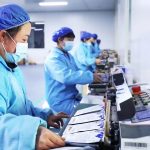In 1868, Heyat developed a plastic material called celluloid. Celluloid was invented by Alexander Parks in 1851. Hyatt improves it so that it can be processed into finished shape. Hyatt and his brother Isaiah, in 1872, registered the patent for the first plunger injector. This machine is relatively simple than that used in the 20 th century. It basically works like a giant hypodermic syringe needle. The giant needle (diffuser) injects plastic into the mold through a heated cylinder.
In the 1940s World War II resulted in a huge demand for cheap, mass-produced products.
In 1946, American inventor James Watson Hendry built the first injection molding machine, which made it more accurate to control the speed and quality of the injection produced. The machine also allows color or recycled plastics to be thoroughly mixed into raw materials before injection. In 1951, the United States developed the first screw injector, which was not patented, and the device is still in use.
In the 1970s, Hendry then developed the first gas-assisted injection molding process, allowing complex, hollow products to cool quickly. This greatly improves design flexibility as well as strength and end-point components, while reducing production time, cost, weight and waste.
Injection molding, also called injection molding, is a method of injection and molding. The advantages of the injection molding method are fast production speed, high efficiency, automation of operation, variety of designs, simple to complex shapes, size from large to small, precise size of products, and easy updating of products. Can form complex shape parts, injection molding suitable for mass production and shape complex products and other molding processing fields.
At a certain temperature, a completely fused plastic material is stirred by a screw, and the molding method is obtained after cooling and curing with high pressure. This method is suitable for mass production of complex parts. It is one of the important processing methods.
The injection molding process can be roughly divided into the following six stages: Moulding, gelling, keeping pressure, cooling, opening mould, product removal
The above process is repeated, can be batch periodic production of products. The molding of thermosetting plastics and rubber also includes the same process, but the temperature of the cylinder is lower than that of the thermoplastic, but the injection pressure is higher, the mould is heated, the material injection needs to be cured or vulcanized in the mould, and then the film is removed while the heat is hot.
Nowadays, the trend of processing technology is developing in the direction of high and new technology. These technologies include micro injection molding, high filling compound injection molding, water assisted injection molding, mixed use of various special injection molding processes, foam injection molding, mold technology, Simulation techniques, etc.
About PTJMould Industrial Company Limited
PTJmould is a manufacturer of plastic molds- injection mold, die casting moulds, plastic blow molding, rotational molding, medical plastic injection molding, two shot plastic injection molding, insert molding, overmolding, metal injection molding, micro injection molding, powder injection molding, ceramic injection molding, liquid injection molding, husky injection molding, household mold, casting mold, die mold tool, custom molds, china moulds, rapid prototyping tooling, plastic prototyping tooling, punch press tooling, die and tooling for mobile/ cell phone parts, automotive parts, vacuum cleaners, rechargeable tools, telephones, copiers, computers, multimedia speakers, and many other electronic products and household appliances. And also a plastic product manufacturer- plastic parts, plastic water tank, plastic balls, plastic containers, plastic buckle, plastic anchor, plastic hanger, plastic spoon, plastic pipe fitting, plastic tumble, plastic tableware, plastic cups, plastic bottles, plastic tray, plastic cosmetic container, plastic case, plastic food container, plastic chairs, plastic caps, plastic cap closure, plastic tubes, plastic water pipes, plastic knobs, plastic tubing, plastic utility boxes, plastic racks and so on.
Link to this article:The History of injection & Injection Molding
Reprint Statement: If there are no special instructions, all articles on this site are original. Please indicate the source for reprinting:Mold Wiki,Thanks!^^


